
Saturday, 15 July 2006
151-33
The Impact of Climatic Changes on Land Capability in the Picasa Lagoon Area, Buenos Aires Province, Argentina.
Gervasio Carboni, Julio M. Sánchez, and Juan C. De La Fuente. INTA-CIRN-Instituto de Suelos, Las Cabañas y De Los Reseros CC 25, Castelar, Argentina
The recorded climatic changes in the Pampean Region of Argentina (1971-2000) indicated an increase in precipitation and temperature values. The Picasa lagoon, covering the south of Santa Fe and north of Buenos Aires provinces, increased its water volume causing the flooding of surrounding agriculture-livestock lands. The objective of this study was to know the effect of climatic changes on the agriculture-livestock land capability in that area. A total of 1,306 ha, near the Picasa Lagoon, were analyzed. The zone has a no-well defined north-south drainage network, unevenness topography, paleodunes, and old deflation basins. The average annual temperature and precipitations (1940-1960) were 14°C and 800-900 mm increasing more than 15% in the 1971-2000 period (900-1,000 mm)16°C. The hydric excess surpassed the evaporation levels. The superposition of 1985 aerial photos at scale 1:50,000 (Graph 1) with 2004 Landsat satelite images (Graph 2) allowed to know the degree of flooding in the studied cartography units. The results indicated that the flooding increased from 7.37% (96.26 ha) to 56.9% (743.13 ha) in the 1985-2004. The laboratory analysis of the 10 cm surface horizon (four soil series) corresponding to the flooded cartographic units indicated a 0.5 pH units and 1.1% total nitrogen decrease, salinity (electric conductivity) increase from 15%, water table elevation up to 45 cm, and humidity saturation in the profiles. The agriculture-livestock lands (IIIws, VIws land capability classes) were reduced in 743.13 ha from 1,209.89 to 562.98 ha (1985-2004). The annual economic losses were calculated in $200-250,000. This research allowed to know the soil chemistry and physical changes, the lost in agriculture-livestock land capability, and economical losses.

Back to 3.2A Environmental Impacts of Soil Erosion - Measuring and Modeling On- and Off-Site Damages of Soil Erosion - Poster
Back to WCSS
Back to The 18th World Congress of Soil Science (July 9-15, 2006)